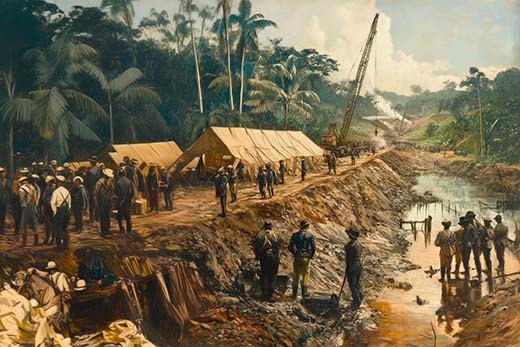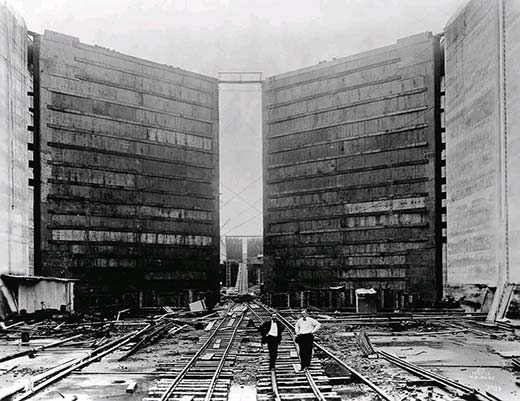Tuesday 22 October 2024

Atlantic to Pacific – The story of the Panama Canal
Speaker: Norman Harris
The guest speaker at u3a Todmorden's October AGM was Norman Harris, a much-travelled retiree, who presented 'Atlantic to Pacific – The story of the Panama Canal'.
Having already completed a journey by that route, Norman set the scene with a short history about when, why, and how, the canal came about. The country of Panama was first mentioned in 1513 by a Spanish explorer who had crossed the Isthmus of Panama and discovered the ocean beyond.

The early days of construction
The Isthmus is a short piece of land which separates the Atlantic Ocean from the Caribbean Sea, and an area of great strategic and geopolitical importance. Creating a gap through the Isthmus would greatly reduce the time taken for ships to carry people, and goods, around the world. An early suggestion to create a canal was rejected, as church leaders said that men should not interfere with God's work in creating the world.
The USA became very keen to lead the project, particularly during the 'gold rush', to speed up the time to convey the gold from west to east. A Scottish company had been formed in the late sixteenth century, and one of their intentions was to create the Panama Canal. Along with their families, the workers travelled to the area, but King William III of England did not allow money to be used for the project. This led to many deaths of the workers, due to the harsh conditions and hunger. Five other routes were proposed by other countries, but due to mountains and other features of the country, the canal option was chosen.
But a French company, The Universal Company of the Interoceanic Canal of Panama, started work on the canal. In 1844 the workforce was around nineteen thousand men, but poor progress had been made, and the company became bankrupt in 1880. USA President Theodore Roosevelt recognised an opportunity in the late nineteenth century, negotiating an agreement with Panama to take over the construction, and sovereignty over the site. This sovereignty lasted until 1977, when it was transferred to Panama until the completion of the canal.
The French efforts had failed, not only because of the disease and heat, but they were trying to dig, and move earth with equipment that was very old, and unsuitable for the task. An architect named Alexander Von Humboldt had already suggested a number of routes, but the Panama Canal was made by building dams on the Chagres River to create Gatun Lake and Lake Madden, digging the Gaillard Cut from the river between the two lakes and over the Continental Divide, building locks between the Atlantic Ocean and Gatun Lake. The six pairs of wooden lock gates for the whole canal are seven feet thick and vary in height from 47 to 82 feet.

Gatun Lock
But the Americans, like their French counterparts, faced the problem of the recruiting, training, and welfare of the workers. Things were even harder because of the struggles with climate, disease, and indecisiveness on the part of managers and architects. Norman showed pictures of the accommodation for workers, for both white men and non white, and locals. The stark variation between people doing mainly the same job would probably not have surprised the audience.
The health of the workforce improved after a doctor called William Gorgas implemented far-reaching sanitary programs, including the draining of ponds and swamps, fumigation, use of mosquito netting, and construction of public water systems. These measures were instrumental in building the Panama Canal, as they significantly prevented illness due to yellow fever and malaria. He was also involved in the building of a hospital for the workers. But still, over five thousand workers died, three hundred of which were white Americans, the rest were Indians and local workers.

The gates at Gatun Lock
John Stevens was appointed Chief Engineer of the Panama Canal Project in 1905. He drew up logical plans for the canal's construction. One of the things he did was to ask 27-year-old manager Ralph Budd to take on the difficult job of rebuilding the railway track across the Panamanian Isthmus. The finished product was a system efficient enough to operate around the clock, effectively acting as a giant conveyor belt for excavated spoil.
Budd also managed another project, the Culebra Cut, which had been started by the French workers. It would be wider but not as deep, as part of a new plan for an elevated lock-based canal, with a bottom width of 91 metres (299 ft); this would require creation of a valley up to 540 metres (0.34 mi) wide at the top. A vast amount of new earthmoving equipment was imported for this task. The original locks are 33.5 metres wide and 320 metres long. They have a thickness of 15 metres at the base and 3 metres at the top, and the lock gates in the third set of locks are 30 meters high, 58 metres long, and 8–10 metres wide, and weigh up to 4,400 tons. These were examples of the size, and scope of the project. We saw an image of the height of the lock gates with some of the workers in the foreground, and Norman reminded us that they had to be constructed and lifted for each stage to get ships up and down for their journey from one ocean to another
Steam shovels broke through the Culebra Cut on May 20, 1913. The Americans had lowered the summit of the cut from 59 to 12 metres (194 to 39 ft) above sea level, at the same time widening it considerably, and they had excavated over 76 million cubic metres (100 million cubic yards) of material.
Norman reminded us of the risks and setbacks of most, if not all, of the construction projects showing us an image of the collapse of the rail tracks as an example.
In November 1906, Theodore Roosevelt paid a visit to see the progress of the Panama Canal, becoming the first president to leave the USA while in office.
The canal has reduced the sailing distance from Atlantic to Pacific and vice versa by a huge 8000 nautical miles (approximately). Before it was built, journeys with an average speed of about 15 knots, would have taken over three weeks. But now, it takes just around 8 to 10 hours to cross from ocean to ocean.
Our speaker shared recollections of his trip through the canal. He noticed that both sides of the waterway look perfectly natural and told us that animals have been re-introduced to the area. The ship he was on was under the control of one of the pilots, who were given a warm welcome when they came aboard. The pilot was to ensure that the vessel remained perfectly straight as it went up and down the locks, the gaps on either side extremely small. A third set of locks is currently under construction to cater for the much larger container ships of modern times. One of Norman's final pieces of information was how much his ship's owners were charged for the passage through the Panama Canal? Around four hundred thousand U.S. dollars.
The audience enjoyed an absorbing and entertaining presentation for slightly less than that, paying with a round of applause for their afternoons' speaker.
The next guest speaker will be James Ellison with 'Real Cop, Literary Cop'
Not yet a member? We're always delighted to welcome new members. Contact details: website at www.u3atod.org.uk or email at info@u3atod.org.uk.
Many thanks to Colin Sanson for this report
Previous U3A reports on the HebWeb - click here

